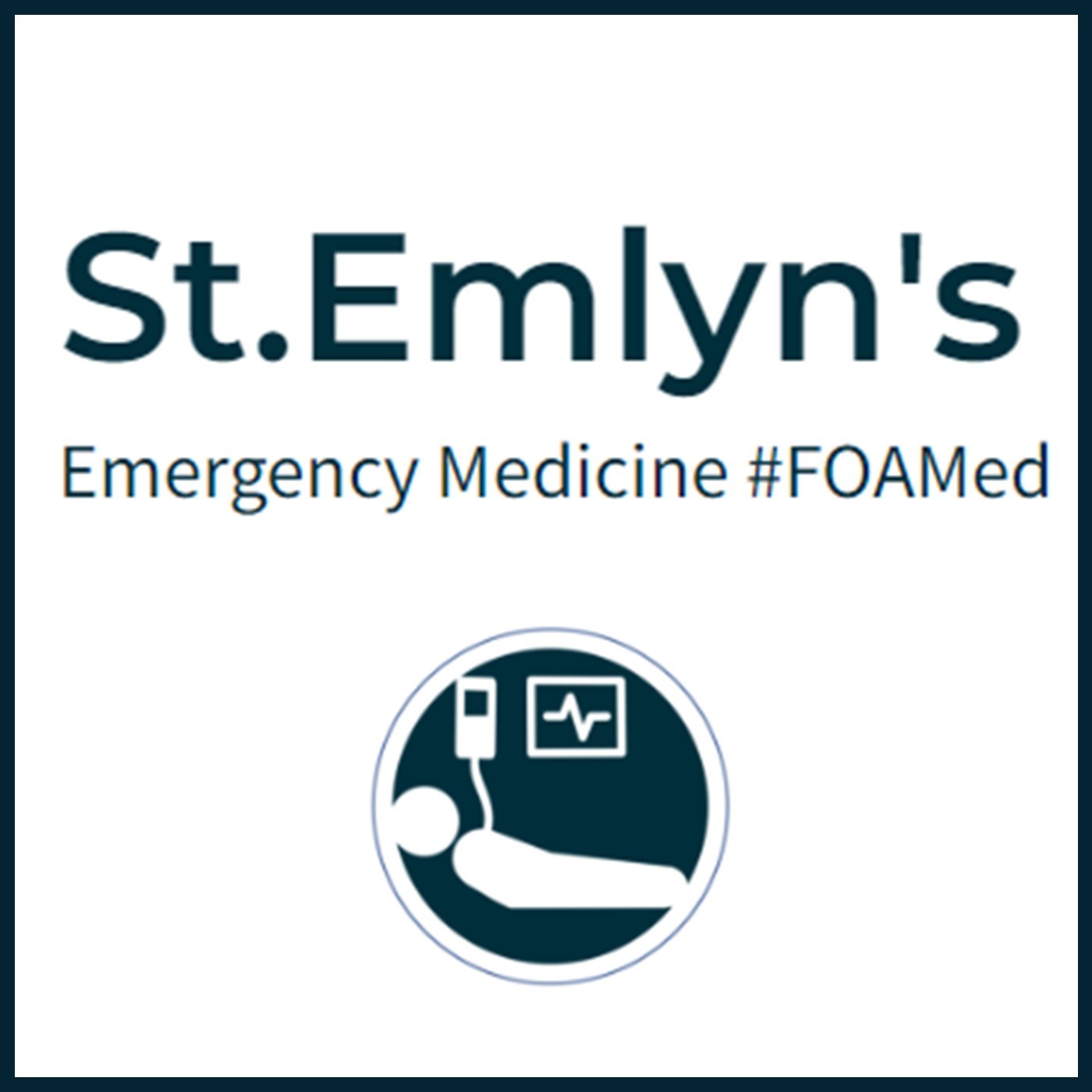
1.3M
Downloads
282
Episodes
A UK based Emergency Medicine podcast for anyone who works in emergency care. The St Emlyn ’s team are all passionate educators and clinicians who strive to bring you the best evidence based education. Our four pillars of learning are evidence-based medicine, clinical excellence, personal development and the philosophical overview of emergency care. We have a strong academic faculty and reputation for high quality education presented through multimedia platforms and articles. St Emlyn’s is a name given to a fictionalised emergency care system. This online clinical space is designed to allow clinical care to be discussed without compromising the safety or confidentiality of patients or clinicians.
Episodes

Saturday Nov 29, 2014
Ep 27 - Intro to EM: The patient with chest pain
Saturday Nov 29, 2014
Saturday Nov 29, 2014
Top Five Diagnoses to Rule Out in Patients with Chest Pain
In emergency medicine, our primary objective is to rule out life-threatening conditions first. This principle guides our approach to patients with chest pain. Here are the top five diagnoses to consider:
- Acute Coronary Syndrome (ACS)
- Pulmonary Embolism (PE)
- Pneumothorax
- Pneumonia
- Aortic Dissection
These conditions can have overlapping symptoms but differ significantly in their management and prognosis. Let’s explore these further.
Acute Coronary Syndrome (ACS)
When a patient presents with chest pain, ACS is often the first concern. Key symptoms include central crushing chest pain, which may radiate to the arm or neck. While classic presentations are familiar to most, not all patients exhibit textbook symptoms. Factors like age, gender, and comorbidities can alter the clinical picture.
Initial Assessment and ECG Interpretation
Every patient with chest pain should receive an ECG as part of the initial workup. Interpreting ECGs requires a high level of expertise, as subtle changes can indicate significant pathology. In our department, only senior emergency physicians are tasked with reading initial ECGs to minimize the risk of missing critical findings. It's important to assess each ECG independently, even if previous records are available, as baseline abnormalities can obscure new, acute changes.
Troponin Testing
For patients where myocardial ischemia is suspected, a troponin test, particularly high-sensitivity troponin, is essential. This biomarker helps identify myocardial injury, even in cases where the ECG does not show definitive changes. Given the serious implications of missing an ACS diagnosis, a low threshold for testing is prudent. Approximately 10% of patients with a normal ECG may still have significant disease, highlighting the importance of comprehensive evaluation.
Pulmonary Embolism (PE)
Pulmonary embolism is another critical condition to consider, especially in patients presenting with pleuritic chest pain, shortness of breath, or risk factors such as recent immobilization, malignancy, or surgery. The clinical presentation of PE can vary, complicating diagnosis.
Clinical Decision Tools
The Wells score and PERC (Pulmonary Embolism Rule-out Criteria) are valuable tools in assessing the likelihood of PE. For low-risk patients, D-dimer testing can be used to rule out the condition, reducing the need for further imaging. However, for patients deemed at higher risk, CT pulmonary angiography (CTPA) is the gold standard for diagnosis. The decision to pursue imaging should be guided by clinical judgment and, where necessary, discussed with senior colleagues to avoid unnecessary radiation exposure and follow-up testing.
Pneumothorax
Pneumothorax should be considered in both young, otherwise healthy individuals and older patients with underlying lung disease. The hallmark symptom is sudden onset pleuritic chest pain, often accompanied by shortness of breath.
Diagnostic Approach
A chest x-ray is typically sufficient to diagnose pneumothorax. Given the low radiation dose and high diagnostic yield, x-rays should be performed for most patients with suspected pneumothorax. The imaging will not only confirm the presence of air in the pleural space but also help assess the severity and guide management decisions.
Pneumonia
Pneumonia is a common cause of chest pain, often accompanied by fever, cough, and sputum production. It is more common in patients with a history of respiratory disease or immunosuppression.
Identifying Pneumonia
A chest x-ray remains the cornerstone of pneumonia diagnosis. Clinical symptoms, such as productive cough and fever, along with imaging findings of consolidation, help differentiate pneumonia from other causes of chest pain. While not immediately life-threatening in most cases, timely recognition and treatment are crucial to prevent complications.
Aortic Dissection
Aortic dissection is a less common but highly dangerous cause of chest pain. Classic symptoms include severe, tearing pain radiating to the back. It is critical to maintain a high index of suspicion for aortic dissection, especially in patients with risk factors such as hypertension, connective tissue disorders, or a family history of the condition.
Confirmatory Testing
The definitive diagnostic test for aortic dissection is a CTA aortogram. While a chest x-ray can sometimes reveal mediastinal widening, it is not sufficiently sensitive to rule out dissection. Early consultation with cardiothoracic surgery and rapid imaging are key to managing suspected cases.
Communicating with Patients
Once life-threatening causes have been ruled out, patients often seek answers about their symptoms. When the etiology remains unclear, it’s important to communicate transparently with the patient. Possible benign causes include musculoskeletal pain or gastroesophageal reflux disease (GERD). While it’s reassuring to exclude serious conditions, acknowledging the limitations of our diagnostic tools and advising patients to return if symptoms change is crucial.
Patient Reassurance and Follow-up
Patients should be advised to follow up with their primary care physician for further evaluation and management of non-urgent conditions. Clear communication, including documenting your diagnostic reasoning and plan, is vital for medico-legal protection and patient safety.
Conclusion: Mastering Chest Pain in the ED
Chest pain remains a complex and multifaceted challenge in the emergency department. The ability to swiftly differentiate between benign and life-threatening causes is a critical skill for emergency physicians. Our approach should be guided by a thorough history, physical examination, and appropriate use of diagnostic tools. Remember, the primary goal is to exclude serious conditions, ensuring patient safety while avoiding unnecessary investigations.
As you continue your journey in emergency medicine, refine your skills in evaluating chest pain. Be diligent in your assessments, stay updated with the latest guidelines, and always communicate clearly with your patients and colleagues. This comprehensive approach will not only improve patient outcomes but also enhance your clinical practice.
Read the blog post here

Monday Nov 24, 2014
Ep 26 - Intro to EM: The ED approach to the child with shortness of breath
Monday Nov 24, 2014
Monday Nov 24, 2014
Managing Shortness of Breath in Pediatric Patients: A Comprehensive Guide
Welcome to the St. Emlins blog. I’m Iain Beardsell, and I’m joined by our resident pediatric expert, Natalie May. Today, we’re discussing a challenging but crucial topic for those in Emergency Medicine: managing pediatric patients with shortness of breath.
Understanding Pediatric Shortness of Breath
Shortness of breath in children is a frequent and often intimidating presentation in the emergency department, especially during winter. This guide aims to provide a systematic approach to assess and manage these young patients effectively.
Initial Assessment: Stay Calm and Structured
When managing a child with shortness of breath, it's essential to stay calm and use a structured approach:
- Level of Consciousness: Determine if the child is alert or needs immediate resuscitation.
- Breathing Effort: Look for signs of respiratory distress such as the use of accessory muscles, intercostal and subcostal recession, tracheal tug, or head bobbing in infants.
- Breathing Efficacy: Listen for extra sounds like wheezes or stridor to identify the underlying pathology.
- Oxygen Delivery: Check the child's oxygen saturation, level of consciousness, and heart rate to evaluate breathing effectiveness.
Oxygen Administration: A Safe First Step
Administering oxygen is a safe and effective initial treatment for children with shortness of breath. It is unlikely to cause harm and can be crucial for stabilizing the patient while further assessments are made.
Detailed History and Physical Examination
Gathering a detailed history from the parents is essential:
- Chronology of Events: Determine how long the child has been short of breath.
- Pre-existing Conditions: Ask about any previous lung problems.
- Additional Symptoms: Note any associated symptoms like fever or cough.
- Inhaled Foreign Body: Consider this, especially if the onset of symptoms was sudden.
This information helps in deciding the appropriate therapy and whether the child needs hospital admission.
Common Causes of Pediatric Shortness of Breath
1. Bronchiolitis and Viral Wheeze
Bronchiolitis is a common winter illness in children under two, often caused by respiratory syncytial virus (RSV). Key signs include:
- Respiratory distress with significant use of accessory muscles.
- Wheezing and low oxygen saturation.
- History of recent cold symptoms in the family.
Viral Wheeze often presents similarly but occurs in slightly older children. Differentiating between bronchiolitis and viral wheeze involves assessing the severity and duration of symptoms.
Management:
- Oxygen: Provide supplemental oxygen if saturation levels are low.
- Bronchodilators: Trial with salbutamol through a spacer or nebulizer can be beneficial.
- Steroids: Generally avoided in children under five unless there is a formal asthma diagnosis or previous steroid-responsive episodes.
Admission Criteria:
- Severe respiratory distress.
- Persistent low oxygen saturation.
- Poor feeding and hydration status.
- History of prematurity or chronic lung disease.
2. Croup
Croup is another common viral illness presenting with a characteristic seal-like barky cough and inspiratory stridor. It often worsens at night, causing significant distress to both the child and the parents.
Management:
- Dexamethasone: A single oral dose (0.15-0.6 mg/kg) is effective in reducing airway inflammation and improving symptoms.
- Observation: Monitor the child for 2 hours post-treatment to ensure improvement.
- Calm Environment: Minimize distress and avoid unnecessary interventions that might exacerbate symptoms.
Safety Netting:
- Provide parents with clear instructions on when to return to the hospital, especially if symptoms worsen during the night.
3. Bacterial Infections: Pneumonia
Though less common than viral infections, bacterial pneumonia should be considered, particularly if the child presents with:
- Fever.
- Persistent cough.
- Decreased oxygen saturation.
- Subtle respiratory distress.
Management:
- Chest X-ray: Useful for diagnosis if bacterial infection is suspected.
- Antibiotics: Initiated based on clinical judgment and X-ray findings.
- Admission: Necessary for children with significant respiratory compromise or those unable to maintain adequate oxygen levels.
Special Considerations
Feeding and Hydration
Children with respiratory distress often have poor oral intake, leading to dehydration. Assess feeding history and urine output:
- Supportive Feeding: Nasogastric or intravenous fluids may be required.
- Monitor Hydration: Ensure adequate fluid intake and monitor for signs of dehydration.
Obligate Nasal Breathers
Infants are obligate nasal breathers, and nasal congestion can severely impact their breathing. Simple measures such as nasal saline drops can alleviate congestion and improve breathing.
Inhaled Foreign Bodies
Always consider the possibility of an inhaled foreign body, especially if the presentation is sudden and there is no clear viral cause. A chest X-ray or bronchoscopy may be required for diagnosis and management.
Conclusion: A Structured Approach for Success
Managing pediatric shortness of breath requires a calm, structured approach, leveraging skills from adult practice and adapting them for pediatric patients. Key steps include:
- Initial Assessment: Stay calm and systematic.
- Oxygen Administration: A safe first step.
- Detailed History and Physical Examination: Crucial for diagnosis.
- Management of Common Conditions: Bronchiolitis, viral wheeze, croup, and bacterial pneumonia.
Remember, there is always senior support available, whether from a senior emergency physician or a pediatric colleague. By staying cool and methodical, you can effectively manage these challenging cases and provide excellent care for your young patients.
Stay tuned to the St. Emlins blog for more in-depth discussions on pediatric emergencies and other critical topics in emergency medicine. Stay calm, stay curious, and keep learning.

Wednesday Nov 12, 2014
Ep 24 - Getting started in Emergency Medicine Research
Wednesday Nov 12, 2014
Wednesday Nov 12, 2014
The Challenge and Value of Research in Emergency Medicine: at DGINA 2014
Rick Body's talk from DGINA on the need for research in EM.
Check out the associated blog post at http://stemlynsblog.org
